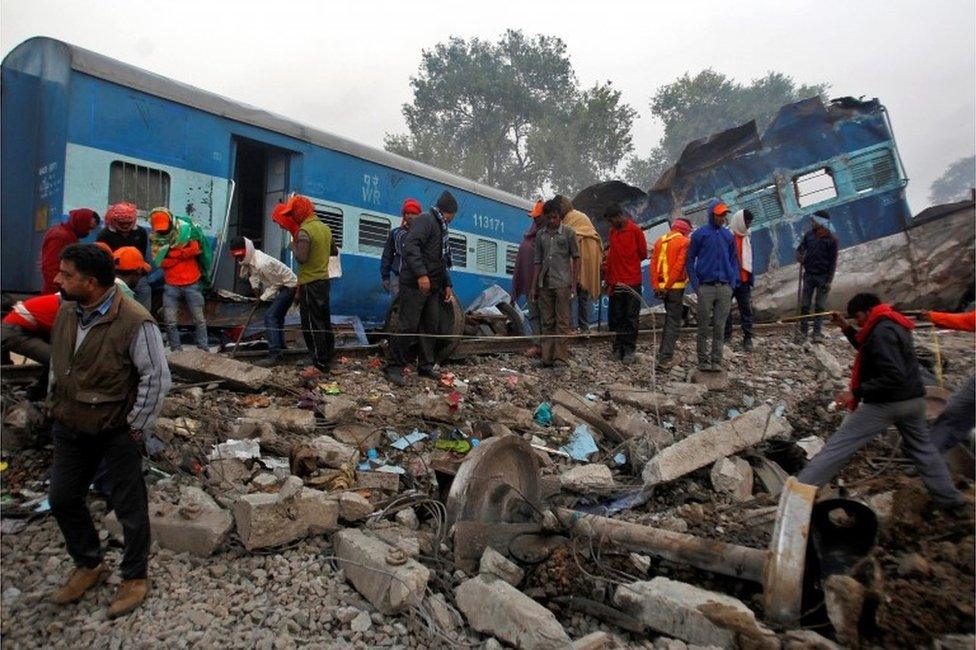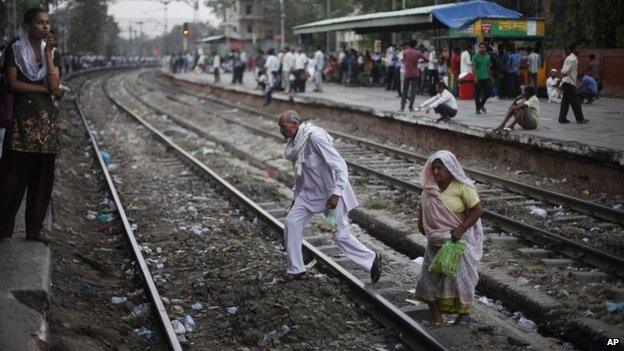Why do India's trains keep going off the rails?
- Published

Sunday's crash was the worst in India in six years
A tremor was followed by a "loud sound like an earthquake". The carriages began to shake and inside them, sleeping passengers began falling on each other. Some carriages telescoped into each other, others rose vertically, "almost standing upright".
Survivors of Sunday's horrific train crash in India also said the train was "rattling" furiously on the tracks hours before the disaster.
What could have led to India's worst train crash in six years, according to junior railways minister Manoj Sinha, was a "fracture in the railway track leading to the jamming of wheels". This isn't the first time that India's railway tracks have come under scrutiny.
So why are trains in India going off the rails? Let's look at some facts:
A total of 168 people died in 131 railway accidents in India in 2014-2015, up from 103 fatalities in 117 accidents in 2013-2014. (India's accident rate per million train kilometres - 0.20 - in 2012-13 compares favourably with that of advanced railways in Europe - Germany and France, for example, both recorded 0.17 accidents per million train kilometres in 2012 - but India's figures mask major deficiencies.)
Derailment was the reason for 60 of the 131 accidents in 2014-2015. (Derailment was responsible for 962 of the 1,201 rail accidents in 1965-66, so the numbers have also gone down.)
The majority of these accidents - 115 - were attributed to human failures - "failure of railway staff and failure of persons other than railways staff". Curiously, track failures, according to official data, did not contribute to a single accident.
But some experts believe that this doesn't quite square up with the state of India's railway tracks. Now, consider this:
India has nearly 115,000km (71,457 miles) of railway tracks.
A 2015 assessment by the railways ministry says some 4,500km of track should be "renewed" every year.
But a lack of funds has meant that construction of new tracks and replacement of the old are not happening at the desired pace. Only 2,100km of tracks were targeted for "renewal" in 2015.
The fracturing of tracks - often caused by expansion of tracks in summer, and contraction in winter - is "the nightmare of the [railways] engineering department", an internal railways memo in 2014 said. "Winter is approaching very fast. All preventive steps like winter patrolling, testing etc should be ensured to detect rail and weld fractures well in time." One report, external said 136 cases of fractured tracks had been detected and repaired between January and May this year.

India's railway tracks need more investment
That's not all.
Funds are needed to replace outdated carriages, which comprise the bulk of the 53,000-strong fleet. Crashes between trains and vehicles account for a large number of accidents - there are still more than 10,000 unmanned crossings in India.
At the root of India's scrappy railway safety standards is lack of funds and chronic under-investment. Last year's assessment admitted that "investments in safety have been insufficient".
Former railway minister Dinesh Trivedi told me that India's railways were "bankrupt". "The focus has shifted from operations to cosmetic changes," he said.
Revenues have indeed plummeted, external - they grew by only 4.6% in 2015-16, lower than the 10-19% growth in the previous four fiscal years. Reason: declining freight because of an economic slowdown and a slight fall in passenger bookings.
Prime Minister's Narendra Modi's government has announced a showpiece bullet train project, external and more high speed trains, improved passenger amenities and free wi-fi at stations. But many say it first needs to ensure that passengers complete their journeys alive.